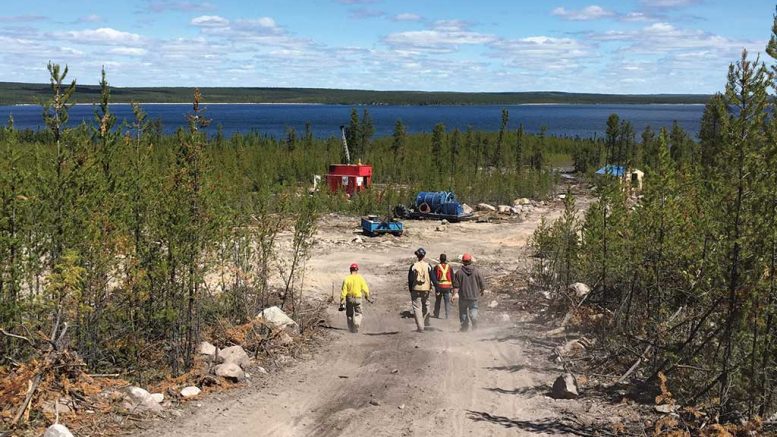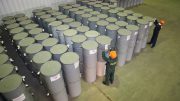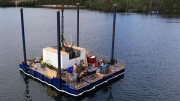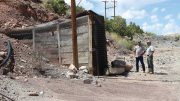NexGen Energy (TSX: NXE; US-OTC: NXGEF) has kicked off a $14-million winter 2017 drill program at its Rook I property in Saskatchewan’s Athabasca basin.
The program will comprise seven drill rigs and a minimum of 35,000 metres. Four rigs started turning on the property’s Arrow uranium deposit on Jan. 23, with the other three set to start in the coming days.
From the three, the Arrow deposit will receive one rig for a total of five. The other two rigs will be used to test the ZTEM and VTEM anomalies, which sit 600 metres northeast and 400 metres southeast of Arrow.

The Rook I camp in Saskatchewan’s southwest Athabasca basin. Credit: NexGen Energy.
The objectives of the program are to continue from where the 2016 drilling left off, NexGen’s CEO Leigh Curyer tells The Northern Miner. Those objectives include expanding Arrow’s known mineralization through aggressive step-out drilling, infill drilling and assessing two geophysical targets near Arrow. Eighty-five percent of the winter drilling will focus on the Arrow deposit, with the rest testing the nearby anomalies.
Discovered in February 2014, Arrow has grown to take the title of third-largest uranium resource in the Athabasca basin, behind Cameco’s (TSX: CCO; NYSE: CCJ) McArthur River and Cigar Lake operations. At year-end 2015, uranium reserves and resources at McArthur River totalled 401 million lb., and 328 million lb. at Cigar Lake.
As of March 2016, Arrow contained 3.5 million inferred tonnes grading 2.6% uranium oxide (U3O8) for 201.9 million lb. U3O8. This includes a higher-grade resource of 410,000 tonnes at 13.3% U3O8 for 120.5 million lb. in the A2 shear.
The deposit’s global uranium resource is “very high grade,” considering the world’s average production grade is 0.1%, Curyer says.
The current resource contains less than 60,000 metres drilled before October 2015. NexGen completed another 73,000 metres in 2016. It plans to table an updated resource estimate in March or April, which would exclude the 2017 drilling.

The Rook I camp in Saskatchewan’s southwest Athabasca basin. Credit: NexGen Energy.
The upcoming estimate should indicate a “material” increase in the overall quantity of pounds and a large conversion of inferred resources into the indicated category, Curyer says. He adds that more drilling would be needed to understand the deposit, which keeps growing and remains open for expansion.
Meanwhile, NexGen is conducting geotechnical drilling and continuing with environmental and engineering test work to support a prefeasibility study (PFS), expected out by year-end. Curyer anticipates the PFS will show that Arrow could be a long-life mine with a production profile that would place it among the world’s top uranium mines.
After this economic study, NexGen will seek permits related to work that would lead to obtaining a mining licence, with Curyer saying that“we expect the permitting around Arrow would be relatively simpler than previous operating mines in Saskatchewan.”
There is no significant surface or underground water at the Arrow deposit, since it is land-based and basement-hosted. It would not require freezing to extract uranium in contrast to a sandstone-hosted deposit such as Cigar Lake, which should accelerate permitting times.
“From a metallurgical perspective, our ore is clean. We don’t have deleterious metals or anything like that in the ore itself,” Curyer says.
While NexGen has three discoveries outside of Arrow on the Rook I property — including the August 2016 Harpoon discovery — it plans to keep the spotlight on Arrow in the near-term.
“It’s always difficult to take a rig off and test those targets when Arrow is still so undefined. We really need to understand Arrow before we emphasize those higher regional targets.”
Some highlights from Arrow’s 2016 drilling include the expansion of the A2 high-grade domain, growth in the A1 shear and confirmation that the deposit connects to the southwest area, 180 metres away. However, there is not enough data to include the southwest area in the upcoming resource estimate.
The Arrow deposit holds five vertical parallel shears — A1 to A5 — that vary from four to 25 metres thick. The mineralized area is 280 metres wide by 870 metres in strike, with mineralization starting at 100 metres below surface and extending to 920 metres deep. The deposit remains open in all directions.
NexGen has $74 million in its treasury, which Curyer says is enough to fund the company’s activities for three years.
On Jan. 24, the stock closed at $3.67 — gaining 12% over the two trading sessions since announcing the 2017 drill program. Over the past year, NexGen shares have jumped 383% from 76¢.






Be the first to comment on "NexGen resumes drilling at Arrow"